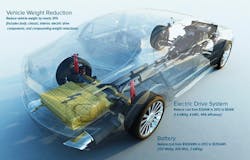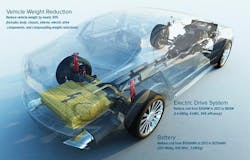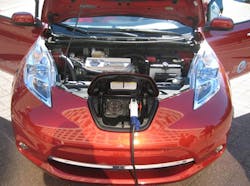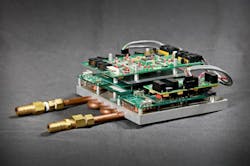Department of Energy Aims to Lower Cost and Improve Range of Electric Cars
VTO’s R&D programs cover areas that impact the success of future generations of EVs (Fig. 1). Power electronics is one of the key areas because it processes and controls the flow of power in hybrid and plug-in electric vehicles. Power electronics also control the speed of the motor, and the torque it produces. Plus, they convert and distribute power to other vehicle systems such as heating and ventilation, lighting, and infotainment. Power electronics components include inverters, DC/DC converters, and chargers for plug-in EVs.
The inverter is an important power electronics subsystem the converts the DC from a battery to AC power to drive a motor. An inverter also acts as a motor controller and as a filter to isolate the battery from potential damage from stray currents. VTO's R&D in power electronics focuses on improving inverters. Researchers are working to reduce inverter volume by a third, reduce parts count by integrating functionality, and reduce cost. Other research focuses on new designs that can enable modular, scalable components.
One approach to improve inverters is to use wide band gap (WBG) semiconductors instead of silicon devices. WBG semiconductors are more efficient and can withstand higher temperatures than silicon components. The ability to operate at higher temperatures can decrease system costs by reducing the requirements for complex thermal management systems. Because of these advantages, wide band gap devices offer significant potential to meet VTO's year 2022 program targets. VTO is supporting research on the two most commonly used WBG materials, silicon carbide (SiC) and gallium nitride (GaN).
Achieving the 2022 targets for power electronics will require advances in several other areas as well, including device packaging, innovative power module designs, and high-temperature capacitors. Device packaging and innovative power module designs can eliminate existing interface layers and provide cooling at or very near heat sources. Improved capacitors can reduce inverter cost and volume, and enable higher temperature operation.
VTO is also supporting research to improve DC/DC converters by developing next generation topologies that are more efficient, reduce parts count, and enable modular, scalable devices. If the vehicle electric motor design requires higher voltage, it will require a boost converter. If lighting or infotainment systems require lower voltages, a buck converter can reduce it to 12V to 42V.
Battery chargers for plug-in electric vehicles are currently based on proven, traditional, high-frequency charger circuits and can be located either on the vehicle or off board, as part of a DC fast charger. Researchers are investigating on-board concepts that integrate the charging function into the existing power electronics and utilize the inductance of the electric motor for recharging. This strategy will lower the parts count and reduce the cost, weight, and volume of existing chargers. As with other power electronics, chargers must have a small physical footprint, be lightweight, and offer high efficiency and high reliability at low cost.
Like the engines in conventional vehicles, the advanced batteries in EVs are designed for extended life, but will wear out eventually. Currently, most manufacturers are offering 8-year/100,000-mile warranties for their batteries. Nissan is providing additional battery capacity loss coverage for 5 years or 60,000 miles. Manufacturers have also extended their coverage in states that have adopted the California emissions warranty coverage periods, which require at least 10-year coverage for batteries on partial zero-emissions vehicles (which include EVs).
EV Range
EV driving range after a charge is a major consideration of vehicle owners (Fig. 2). Efficiency and all-electric driving range of plug-in electric vehicles depends on a number of factors, including driver habits, driving conditions, and temperature, such as hot or cold weather. For an all-electric vehicle, reduced range may mean the driver will need to charge more often, depending on daily miles traveled. For plug-in hybrid electric vehicles, the internal combustion engine will turn on more quickly, increasing fuel cost and emissions.
Extreme weather - very hot or very cold - impacts range in EVs. The additional heating or cooling needed for passenger comfort requires more energy than more moderate temperatures would. Cold batteries also have greater resistance to charging and do not hold a charge as well.
Based on nearly 10 million miles of data collected through the EV Project, researchers at Idaho National Laboratory found that variations in weather can affect the range of plug-in electric vehicles by more than 25%. They found all-electric Nissan Leafs driven in Chicago in the winter had 26% lower ranges (60 miles compared to 81) than those driven in Seattle in the fall. Similarly, they found that plug-in hybrid electric Chevrolet Volts driven in Chicago in the winter had 29% lower ranges (30 miles compared to 42) than those driven in Chicago in the spring.
EV manufacturers and research supported by the DOE are improving temperature-control technology to compensate for some of these issues. For instance, several models are now available with battery heaters or other technology to heat the battery and improve efficiency in cold climates.
There are many things drivers can do to improve the efficiency of their vehicles. Here are some specific tips for EVs:
- Use accessories wisely: Accessories such as heating, air conditioning, and entertainment systems affect fuel economy on all vehicles, but can have a greater effect on EVs. However, using seat warmers instead of the cabin heater can save energy and extend range.
- Use the economy mode: Many EVs come with an "economy mode" or similar feature that maximizes the vehicle's fuel economy. In some vehicles, this mode can be activated by simply pressing a button. The economy mode may limit other aspects of the vehicle's performance, such as acceleration rate, to save fuel.
- Plan ahead before driving: Pre-heating or pre-cooling the cabin of an all-electric or plug-in hybrid electric vehicle while it is still plugged in can extend its electric range, especially in extreme weather.
- Avoid hard braking and anticipate braking: This allows the vehicle's regenerative braking system to recover energy from the vehicle's forward motion and store it as electricity. Hard braking causes the vehicle to use its conventional friction brakes, which do not recover energy.
- Observe the speed limit: Efficiency usually decreases rapidly at speeds above 50 mph.
- Other ways to improve efficiency include avoiding hauling cargo on your roof, removing excess weight, and keeping your tires properly inflated.
Energy Router
Charging a battery at home is being addressed by The Power Electronics and Electric Machinery (PEEM) Research Center at Oak Ridge National Laboratory (ORNL). This project involves the ENABLE platform, an energy router for the modern household (Fig. 3). Directing energy flows and syncing a home’s electricity generation sources like solar power with the utility grid would get a lot easier with a single, easy-to-use platform that is the aim of a recent research and development agreement between ORNL and Flex Power Control (Woodland Hills, CA).
Under the agreement, researchers at ORNL will develop power conversion hardware for Flex Power’s home energy router, dubbed the Smart Power Integrated Node, or SPIN. SPIN would combine into a single unit all the functions of an inverter for solar power and backup battery storage, as well as working as an electric vehicle fast charger, a power quality corrector, and energy meter—resulting in an adaptive controlled distributive energy resource.
While homes and businesses are typically wired for AC current, solar panels produce high-voltage DC power, and batteries and many appliances use DC current—requiring that power be converted and stepped-down to appropriate voltages for appliances as needed. If every energy resource in a modern, self-sustaining home needs its own power conversion system, the result is redundancy, higher cost, and less efficient coordination and energy conversion efficiency.
The home energy router would replace those individual inverters and controls and connect homes to the utility grid with a single interface. It would allow “plug and play” of new renewable energy sources, passive and active loads, and their power conversion modules. With further development by Flex Power, for instance, the router could sense your usage and compare it against a utility’s rate structure, automatically finding the best times to either keep electricity at your home or to sell it profitably into the grid.
The hardware to be created for Flex Power is based on the ENABLE (Environmentally Neutral Automated Building Electric Energy) platform developed by ORNL’s PEEM group within the Electrical and Electronics Systems Research Division. The platform uses advanced wide-bandgap semiconductors that can operate at much higher voltages, as well as 3D-printed heat sinks that dissipate the heat generated by the device. The result will be a much smaller, more efficient router.
“The original idea was, we have Internet routers at home, why not have something that routes energy?” said principal investigator and PEEM Group Leader Burak Ozpineci. “The ENABLE platform could essentially replace much of the function of electrical panels in homes,” he added, “with the potential to even be controlled using an app on your phone.”
“We are seeing more introduction of DC power into the home, mainly because of solar panels and electric vehicles and even backup battery energy storage,” said Flex Power Control President Greg Smith. “It all needs to be converted and routed seamlessly.”
Safety
EVs must undergo the same rigorous safety testing and meet the same safety standards required for conventional vehicles sold in the United States as well as EV-specific standards for limiting chemical spillage from batteries, securing batteries during a crash, and isolating the chassis from the high-voltage system to prevent electric shock. In addition, EVs tend to have a lower center of gravity than conventional vehicles, making them less likely to roll over and often improving ride quality.
One safety concern specific to EVs is their silent operation; pedestrians may be less likely to hear an EV than a conventional vehicle. The National Highway Traffic Safety Administration is studying ways to address this issue, such as requiring EVs to emit audible sounds at low speeds. This option is already available on many EVs, including the Chevrolet Volt and Nissan Leaf. In any case, you should use extra caution when driving your EV in pedestrian areas.
Because of their differing technologies, all-electric vehicles (AEVs) and plug-in hybrid electric vehicles (PHEVs) have different types of required maintenance. Both will require minimal scheduled maintenance to their electrical systems, which can include the battery, electrical motor, and associated electronics. However, because of regenerative braking, brake systems on EVs typically last longer than on conventional vehicles.
In general, AEVs require less maintenance than conventional vehicles because there are usually fewer fluids (like oil and transmission fluid) to change and far fewer moving parts. In contrast, because PHEVs have gasoline engines, maintenance requirements for this system are similar to those in conventional vehicles.
About the Author

Sam Davis
Sam Davis was the editor-in-chief of Power Electronics Technology magazine and website that is now part of Electronic Design. He has 18 years experience in electronic engineering design and management, six years in public relations and 25 years as a trade press editor. He holds a BSEE from Case-Western Reserve University, and did graduate work at the same school and UCLA. Sam was the editor for PCIM, the predecessor to Power Electronics Technology, from 1984 to 2004. His engineering experience includes circuit and system design for Litton Systems, Bunker-Ramo, Rocketdyne, and Clevite Corporation.. Design tasks included analog circuits, display systems, power supplies, underwater ordnance systems, and test systems. He also served as a program manager for a Litton Systems Navy program.
Sam is the author of Computer Data Displays, a book published by Prentice-Hall in the U.S. and Japan in 1969. He is also a recipient of the Jesse Neal Award for trade press editorial excellence, and has one patent for naval ship construction that simplifies electronic system integration.
You can also check out his Power Electronics blog.



